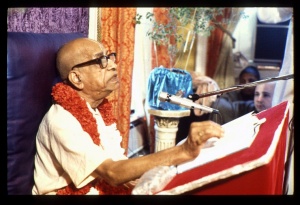CC Madhya 22.142 (1975): Difference between revisions
(Vanibot #0027: CCMirror - Mirror CC's 1996 edition to form a basis for 1975) |
(Vanibot #0020: VersionCompareLinker - added a link to the Version Compare feature) |
||
| Line 2: | Line 2: | ||
<div style="float:left">'''[[Sri Caitanya-caritamrta (1975)|Śrī Caitanya-caritāmṛta (1975)]] - [[CC Madhya (1975)|Madhya-līlā]] - [[CC Madhya 22 (1975)|Chapter 22: The Process of Devotional Service]]'''</div> | <div style="float:left">'''[[Sri Caitanya-caritamrta (1975)|Śrī Caitanya-caritāmṛta (1975)]] - [[CC Madhya (1975)|Madhya-līlā]] - [[CC Madhya 22 (1975)|Chapter 22: The Process of Devotional Service]]'''</div> | ||
<div style="float:right">[[File:Go-previous.png|link=CC Madhya 22.141 (1975)|Madhya-līlā 22.141]] '''[[CC Madhya 22.141 (1975)|Madhya-līlā 22.141]] - [[CC Madhya 22.143 (1975)|Madhya-līlā 22.143]]''' [[File:Go-next.png|link=CC Madhya 22.143 (1975)|Madhya-līlā 22.143]]</div> | <div style="float:right">[[File:Go-previous.png|link=CC Madhya 22.141 (1975)|Madhya-līlā 22.141]] '''[[CC Madhya 22.141 (1975)|Madhya-līlā 22.141]] - [[CC Madhya 22.143 (1975)|Madhya-līlā 22.143]]''' [[File:Go-next.png|link=CC Madhya 22.143 (1975)|Madhya-līlā 22.143]]</div> | ||
{{CompareVersions|CC|Madhya 22.142|CC 1975|CC 1996}} | |||
{{RandomImage}} | {{RandomImage}} | ||
==== TEXT 142 ==== | ==== TEXT 142 ==== | ||
<div class="verse"> | <div class="verse"> | ||
:vidhi-dharma | :vidhi-dharma chāḍi' bhaje kṛṣṇera caraṇa | ||
:niṣiddha pāpācāre tāra kabhu nahe mana | :niṣiddha pāpācāre tāra kabhu nahe mana | ||
</div> | </div> | ||
| Line 18: | Line 17: | ||
<div class="synonyms"> | <div class="synonyms"> | ||
vidhi-dharma | vidhi-dharma chāḍi'-giving up all regulative principles of the varṇa and āśrama institution; bhaje—worships; kṛṣṇera caraṇa—the lotus feet of Lord Kṛṣṇa; niṣiddha—forbidden; pāpa-ācāre—in sinful activities; tāra—his; kabhu—at any time; nahe—not; mana—the mind. | ||
</div> | </div> | ||
| Line 25: | Line 24: | ||
<div class="translation"> | <div class="translation"> | ||
"Although the pure devotee does not follow all the regulative principles of varṇāśrama, he worships the lotus feet of Kṛṣṇa. Therefore he naturally has no tendency to commit sin. | |||
</div> | </div> | ||
| Line 34: | Line 33: | ||
The varṇāśrama institution is planned in such a way that one will not commit sinful activities. Material existence continues due to sinful activity. When one acts sinfully in this life, he gets a suitable body for the next life. When one again acts sinfully, he takes on another material body. In this way one is continuously under the influence of material nature. | The varṇāśrama institution is planned in such a way that one will not commit sinful activities. Material existence continues due to sinful activity. When one acts sinfully in this life, he gets a suitable body for the next life. When one again acts sinfully, he takes on another material body. In this way one is continuously under the influence of material nature. | ||
puruṣaḥ prakṛti-stho hi bhuṅkte prakṛti-jān guṇān | :puruṣaḥ prakṛti-stho hi | ||
kāraṇaṁ guṇa-saṅgo | :bhuṅkte prakṛti-jān guṇān | ||
:kāraṇaṁ guṇa-saṅgo 'sya | |||
Due to our association with the modes of material nature, we get different types of bodies | sad-asad-yoni-janmasu | ||
"The living entity in material nature thus follows the ways of life, enjoying the three modes of material nature. This is due to his association with that material nature. Thus he meets with good and evil among various species." ([[BG 13.22 (1972)|Bg. 13.22]]) | |||
Due to our association with the modes of material nature, we get different types of bodies-good and bad. One cannot be liberated from the cycle of birth and death, known as transmigration of the soul, unless one is completely freed from all sinful activities. The best process, therefore, is to take to Kṛṣṇa consciousness. One cannot take to Kṛṣṇa consciousness without being freed from all sinful activities. Naturally one who is very serious about Kṛṣṇa consciousness is freed from all sinful activity. Consequently a devotee is never inclined to commit sins. If one is pressured by the law or obligations to give up sinful activity, one cannot do so. However, if one takes to Kṛṣṇa consciousness, he can very easily give up all sinful activity. This is confirmed herein. | |||
</div> | </div> | ||
Latest revision as of 14:14, 27 January 2020

A.C. Bhaktivedanta Swami Prabhupada
TEXT 142
- vidhi-dharma chāḍi' bhaje kṛṣṇera caraṇa
- niṣiddha pāpācāre tāra kabhu nahe mana
SYNONYMS
vidhi-dharma chāḍi'-giving up all regulative principles of the varṇa and āśrama institution; bhaje—worships; kṛṣṇera caraṇa—the lotus feet of Lord Kṛṣṇa; niṣiddha—forbidden; pāpa-ācāre—in sinful activities; tāra—his; kabhu—at any time; nahe—not; mana—the mind.
TRANSLATION
"Although the pure devotee does not follow all the regulative principles of varṇāśrama, he worships the lotus feet of Kṛṣṇa. Therefore he naturally has no tendency to commit sin.
PURPORT
The varṇāśrama institution is planned in such a way that one will not commit sinful activities. Material existence continues due to sinful activity. When one acts sinfully in this life, he gets a suitable body for the next life. When one again acts sinfully, he takes on another material body. In this way one is continuously under the influence of material nature.
- puruṣaḥ prakṛti-stho hi
- bhuṅkte prakṛti-jān guṇān
- kāraṇaṁ guṇa-saṅgo 'sya
sad-asad-yoni-janmasu
"The living entity in material nature thus follows the ways of life, enjoying the three modes of material nature. This is due to his association with that material nature. Thus he meets with good and evil among various species." (Bg. 13.22)
Due to our association with the modes of material nature, we get different types of bodies-good and bad. One cannot be liberated from the cycle of birth and death, known as transmigration of the soul, unless one is completely freed from all sinful activities. The best process, therefore, is to take to Kṛṣṇa consciousness. One cannot take to Kṛṣṇa consciousness without being freed from all sinful activities. Naturally one who is very serious about Kṛṣṇa consciousness is freed from all sinful activity. Consequently a devotee is never inclined to commit sins. If one is pressured by the law or obligations to give up sinful activity, one cannot do so. However, if one takes to Kṛṣṇa consciousness, he can very easily give up all sinful activity. This is confirmed herein.